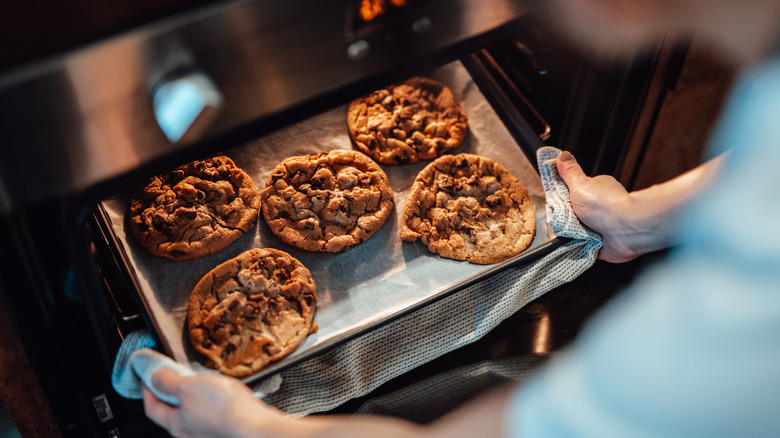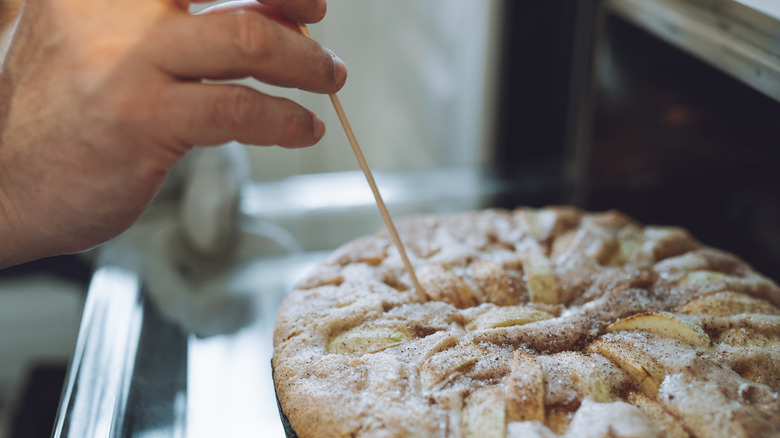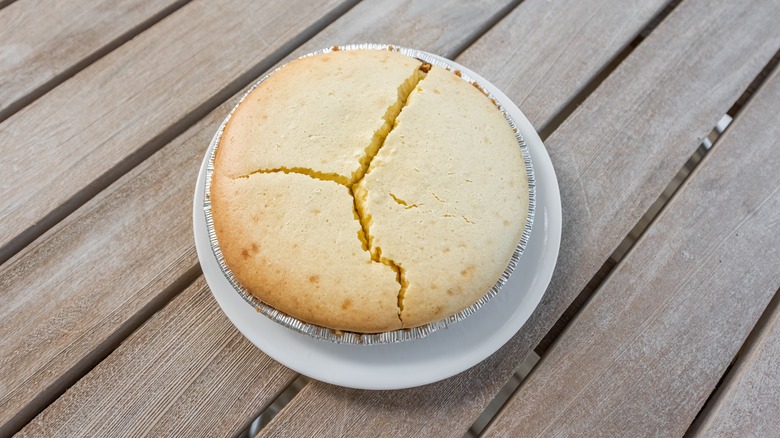The Timing Rule You Need To Follow To Avoid Overbaking Your Treats
For your average at home baker, navigating all of the intricate timings and temperatures involved with baking your favorite sweet (or savory) treats can sometimes feel a bit overwhelming. Underbaking things is okay, to an extent: While not ideal, you can always take a cake out early, check its temperature, and put it back into the oven, after all. Overbaking, though, is another matter — once your bake gets past a certain point, it's very difficult to pull it back. But is there a way to avoid making such a crucial mistake? To find out, Food Republic spoke to Dominique Ansel. He is widely regarded as one of the world's foremost pastry experts, having been the executive pastry chef at New York's two Michelin-starred Daniel for six years (in the process winning a James Beard award and being named the world's best pastry chef in 2017) before founding his eponymous bakery — and, of course, inventing the now iconic cronut.
If anyone knows how to avoid overbaking a tasty treat, it's Ansel. We caught up with him as he prepared for a collaboration with Talenti® Gelato & Sorbetto, creating an exclusive layered dessert inspired by Talenti's new Bakery Collection of gelatos. According to the expert, the best way to keep your baked goods from overcooking is to keep a steady eye on them, testing its contents in the minutes before your timer goes off. There are also multiple tools and tricks that will keep you vigilant while baking, to avoid the dreaded disappointment that comes after your treat had too long of a stay in the oven.
The best way to check if your baked good is done
Even if you merely dabble in at-home baking, odds are you are familiar with the traditional method for checking for the "doneness" of a cake, brownie, or pretty much any other sweet treat by using a toothpick or cake tester. Inserted into the thickest point of your baked good, how much (or little) sticks to your tool once it's removed can give you a good gauge for whether or not your pastries need some more time in the oven. If you don't have one on hand, though, Dominique Ansel has you covered.
"The most reliable and accurate is still the tried and true method of a paring knife (or something similar) piercing into the center to check for doneness," he said. So, as long as you have something long enough, thin enough and sharp enough to not destroy the look (or the structural integrity) of your bake, that classic technique is still the way to go. An important consideration, though, is what consistency you actually want your baked good to be: "the texture you're aiming for each pastry can vary," said Ansel. The texture of a great fudgy brownie is obviously going to be quite different to that of a light, fluffy sponge cake — so the notion that your treat is done when the tester comes out clean might not necessarily be accurate. As long as you keep that in mind, though, it's a pretty foolproof method.
Alternative methods for checking if your pastry is ready
It might be that you have your reasons for not wanting to pierce your baked good with a tester or paring knife. Maybe you're unsure what the correct consistency should be, and you don't want to be misled by a stray bit of batter on your tester. When making denser cakes that require more moisture like a flourless chocolate cake or a decadent olive oil cake, for example, some excess batter is welcomed for that desired bite. Perhaps you're making a particularly delicate sponge, and don't want to risk testing it too early and collapsing your cake — or maybe you just want an alternative that's a little more universal. Well, have no fear!
According to Dominique Ansel, there are a couple of other useful ways to check for doneness that don't involve piercing your sweet treats. "You can also jiggle it once it's out of the oven," the expert explained. When you do, keep a close eye on how the cake moves: "[I]f it's still wobbly, it needs more time in the oven." A flimsy and unbalanced confection indicates that there's a high likelihood that there's still liquid batter inside, meaning it is probably underbaked. Simply relying on touch can also tell you if your baked good is ready. "[Check] by pressing gently into the center, and if the cake springs back, it's ready," Ansel explained. The more you bake, the better you'll get at knowing when your cake is ready — practice makes perfect!
Is there any way to rescue your treats once they've been overbaked?
If, for whatever reason, you don't get to those cakes or cookies in time, is it possible to rescue an overbaked batch? The answer, unhelpful as it may be, is slightly complicated. While it's possible to fix certain foods in specific circumstances — such as repairing the top of a cracked cheesecake, for example — it's often a futile exercise to try and save an overbaked sweet treat. "You can't really go back once something is overbaked," Dominique Ansel told Food Republic. "That's why it's always better to underbake or check before the stated time in the recipe, checking for doneness, then putting it back into the oven for a few more minutes if needed." The expert emphasized that this is an especially useful tip when baking at home, "as ovens behave differently — some can be too hot, some not enough."
But rescuing your pastry doesn't just mean keeping it in its original form. You could always get creative and repurpose your overdone baked goods: brittle cookies could be crushed up for a delicious ice cream topping for your next sundae, or soaked and turned into a cookie-based bread and butter pudding. You could even break out your food processor and turn them into a treat that'll last by grinding them up into a homemade batch of cookie butter. Ideally, you wouldn't have to get so creative, but it is nice to know you have options if your sweet treats end up overbaked.




